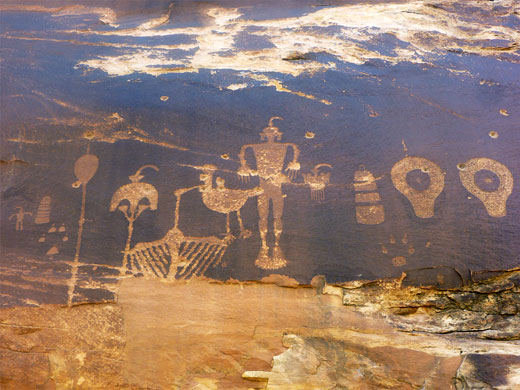Guidelines for Exploring Archaeological Sites
The majority of these archaeological sites are found on the Colorado Plateau of north Arizona, south Utah, northwest New Mexico and southwest Colorado. The best place, with the most concentrated, numerous and well-preserved relics, is Cedar Mesa, where ruins and rock art are found along the major canyon of Grand Gulch, and dozens of tributary ravines - but there are many more locations. Although all archaeological sites viewable by the casual hiker are likely already to have been investigated, recorded and in some cases excavated and stabilized, it is the responsibility of the visitor to treat them with care and respect. Many of the areas are still considered sacred by modern Native Americans.
All archaeological sites included on this website are already relatively well known, documented in guidebooks or on other websites. Ruin and rock art sites are described in some detail, though topographic maps (and GPS coordinates) are not given, so some effort may be required to locate a particular place.
The main rule is to Leave No Trace; to leave the place exactly as found, taking only photographs. Specific rules and guidelines include:
There are several organizations who work to further knowledge and understanding about ancient sites in the Southwest, such as Archaeology Southwest, Bears Ears Partneship and Crow Canyon Archaeological Center.
- Do not collect any object - historical, geological or botanical. Removing or disturbing of historic items is a federal offence, according to the Antiquities Act of 1906 and the Archaeological Resources Protection Act of 1979
- Do not touch or trace rock art - petroglyphs (etchings), pictographs (paintings) or signatures. Oils from the skin can accelerate erosion
- Do not rearrange items, such as by creating piles of pot fragments or other artifacts
- Do not climb, sit or lean on walls and roofs - some may look sturdy but all are potentially delicate and unstable
- Avoid walking on middens - these are ancient refuse heaps, commonly found close to ruins, recognizable by a slightly raised mound, often darker in color than its surroundings
- Do not use ropes or other climbing aids to enter archaeological sites
- If camping is permitted, then camp a reasonable distance away from archeological sites, and do not build fires in the vicinity
- Keep pets leashed at all times, and well away from any archeological sites. In many regions, such as Grand Gulch, all pets are prohibited
- Report any acts of vandalism, to the BLM or other management agency
- Stay on established trails where possible, to reduce erosion
- Do not leave litter, even organic items, as these can attract wildlife, who can damage ruins by burrowing or nest-building
There are several organizations who work to further knowledge and understanding about ancient sites in the Southwest, such as Archaeology Southwest, Bears Ears Partneship and Crow Canyon Archaeological Center.
All Contents © Copyright The American Southwest | Comments and Questions | Contribute | Affiliate Marketing Disclosure | Site Map




